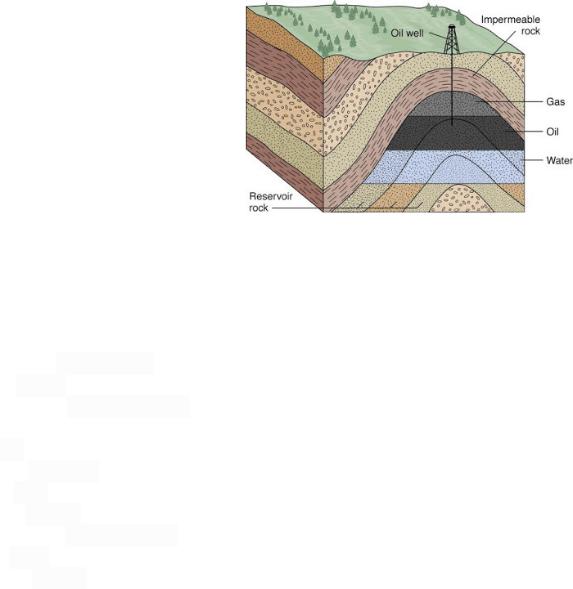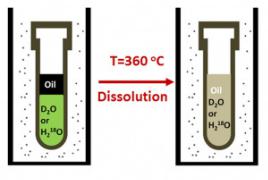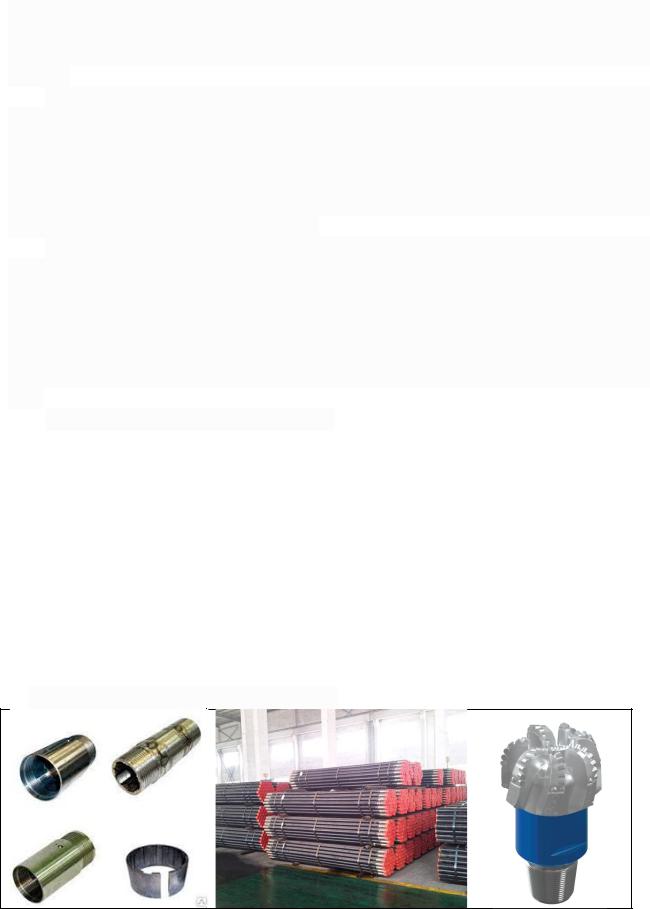
Английский язык для студентов специальности «Нефтегазовое дело». Лавриненко И. Ю., Козлова В. В
.pdf
Oil and gas are found, equipment is removed, people inject oil or gas under the ground, environment is restored, oil and gas are sealed in reservoirs, reservoir is closed, reservoirs are classified, quality and amount of oil are estimated, people put chemicals in a well, oil is taken from the ground.
Task 9. Answer the following questions:
1.What are the main stages of oil production?
2.What happened when the oil is found under the ground?
3.What is the difference between proven reserves, probable reserves and possible reserves?
4.Why are test wells produces?
5.How does production occur?
6.What do production rates depend on?
7.What stages do the lifecycle of a typical well have?
8.What does abandonment stage include?
Task 10. Speak about the process of oil and gas extraction.
PROJECT TIPS
Think of the way the process of oil and gas extraction can be optimized. Think of technology and equipment that can be used to implement it. Report to the class.
Video Materials
a) You are going to watch the Part 2 of the video about natural gas. Before watching make sure you know the words below:
consideration – внимание, рассмотрение land holder - землевладелец
agreement - соглашение drill head – буровая головка
lubricating liquid – смазочная жидкость surface casing – обсадная колонка encounter – встречаться, сталкиваться
b)Follow the link and watch the video: https://www.youtube.com/watch?v=V8EHHW-3N5Y (timing: from 3:18 to5: 58).
c)Watch the video again and fill in the gaps in the sentences below:
1.We start by … a surface hole.
2.When we drill deeper we encounter … levels of … .
3.The lubricating liquid contains … and … .
21

d) After watching (watching twice) answer the questions below:
1.What should be done before the agreement for oil extraction is reached?
2.What happens when the drill head is moved down?
3.Why is lubricating liquid used?
4.How is pressure controlled in the process of drilling?
5.Why is surface casing needed?
6.What is the role of cement in the process of oil extraction?
7.What techniques are used to extract gas?
Lesson 5
OIL AND GAS RESERVOIRS
Task 1. Answer the following questions using the expressions below:
I am not sure, but… . Is far as I know, … . In my opinion, … .
1.What layers does oil and gas reservoir have? How deep do you think the oil reservoir is?
2.How does it happen that oil and gas are kept separates from the other bulk of earth?
3.What else do you know about oil and gas reservoir construction?
Task 2. Read the text below and check your answers for Task 1. The words below will help you understand the text:
1)accumulate [əˈkjuːmjʊleɪt] - накапливать
2)cavity [ˈkavɪti] – впадина, полость
3)conventional [kənˈvɛnʃ(ə)n(ə)l] – привычный, традиционный
4)kerogen - кероген
5)seal [siːl] - запечатывать
6)migrate [mʌɪˈɡreɪt] - перемещаться
7)dense [dɛns] - плотный
8)density [ˈdɛnsɪti] - плотность
9)groundwater [ˈɡraʊn(d)wɔːtə] – грунтовая вода
10)grain [ɡreɪn] – гран, зерно
11)dissolve [dɪˈzɒlv] - растворять
12)sediment grain - осадочные породы
13)anticlines – антиклинали (выпуклый изгиб слоев горных пород)
22
14) cap rock – покрывающая порода
Oil and Gas Reservoir
An oil and gas reservoir is a formation of rock in which oil and natural gas has accumulated. The oil and gas are collected in small pore spaces of rock. They are trapped within the reservoir by overlying impermeable layers of rock. Typical reservoirs are not "pools" or "lakes" of oil beneath the surface, as there are no vast open cavities that contain oil. Oil and gas reservoirs can also be referred to as "hydrocarbon reservoirs".
The picture above represents an anticline oil and gas reservoir.
Conventional hydrocarbon reservoirs consist of three main parts: the source rock, the reservoir rock, and the cap rock (see the picture). The source rock is the rock that contains the kerogen that the oil and gas forms from. The reservoir rock is the porous, permeable rock layer that holds the oil and gas. The cap rock seals the top and sides so that the hydrocarbons are trapped in the reservoir, while water often seals the bottom.
For a reservoir to exist, oil and gas from the source rock must migrate into the reservoir rock, which takes millions of years. This migration occurs because oil and gas are less dense than water. This difference in density causes the oil and gas to rise towards the surface so that they are above groundwater with the gas settling above the oil because of its lighter densities.
Reservoir rocks need to be both porous and permeable. This means that there are small pockets of space within the rock where oil or gas can settle and small channels connecting these pockets to allow the oil or gas to flow out of this rock easily when it is drilled. These spaces between grains can develop as the formation of rock occurs or afterwards, usually as a result of groundwater passing through the rock and dissolving some of the cement between sediment grains.
The rock must be formed or deformed in such a way to create a trap for the oil and gas. Anticlines are the most common formation shape for this to occur. Anticlines are of a rough "A" shape, with the cap rock making the sides of the "A". The fossil fuels are accumulated in the peak of the "A" and the bottom is sealed (usually with water), preventing the oil and gas from seeping out and escaping.
Source: Energy Education, URL: https://energyeducation.ca/encyclopedia/Oil_and_gas_reservoir (время обращения - 26.07.2020).
Task 3. Match the English and Russian equivalents:
1) |
pore spaces |
a) |
непроницаемый слой |
2) |
trap |
b) |
открытые полости |
3) |
impermeable layer |
c) |
меньшая плотность |
4) |
open cavities |
d) |
пористые пространства |
5) |
lighter densityy |
e) |
дно, нижняя часть |
6) |
small channel |
f) |
небольшой канал |
|
|
23 |
|
7) |
bottom |
g) |
выливаться |
8) |
seeping out |
h) |
запирать, закупоривать |
Task 4. What chemical substances are mentioned in the text (there are 5 of them)?
Task 5. Fill in the gaps with the words below, there are three words you don`t need to use:
source rock, bottom, escape, cap rock, seal, density, anticline, migration.
1.… is an impermeable layer of rock that prevent the fluid to escape from cavity.
2.… is a special rock that contains a lot of karogen and hydrocarbons.
3.… is formed from many layers of rock forming arch-shaped fold.
4.Oil and gas have less … than water.
5.The … of oil and gas form the reservoir.
Task 6. Prove the following ideas using the information from the text:
1.There are different kinds of rocks in hydrocarbon reservoir.
2.The cap rock holds hydrocarbons in the reservoir.
3.The gas is located above oil in the reservoir.
4.Reservoir rock contains small pockets of space.
5.Water and anticlines help to keep oil and gas in the reservoir.
Task 7. Answer the following questions:
1.How is oil and gas trapped in reservoirs?
2.What are oil and gas formed from?
3.What is the function of each layer of rock that forms conventional hydrocarbon reservoirs?
4.How does the migration of oil and gas occur?
5.How are spaces between rocks formed?
6.How is the trap of oil and gas in the rock formed?
7.Why oil and gas don`t escape from the trap?
Task 8. Read the information about what is Summary and the discourse markets in the Application 4. Correct the mistakes in the sentences below:
1. The text calls “Types of wells”.
2.It speaks the problem of ecological safety of wells.
3.Firstly, it speak about the geophones used for detecting possible oil deposits.
4.Secondly, it is said cement casing protects digging head from damage.
5.Thirdly, there are some information about workforce employed in oil extraction.
6.Also it is said measurements of the location are important.
7.The article taken from encyclopedia.
8.The article may interest people study oil and gas professionally.
24
Task 9. Read the summary for the text below. All the discourse markers are in the wrong places (mixed up). Put them correctly.
1) The most interesting to read the idea of the construction of oil reservoir. 2) After that, it speaks about oil field and its structure. 3) The text may be taken it goes on speaking about what full exploitation means. 4) Firstly, there is some information
about the infrastructure needed for the oil field functioning. It is a large scale infrastructure with a lot of drilling rigs and pump jacks. 5) Then, about the famous Arabian and American companies – leaders in oil extraction. In the end the author speaks about three sectors of oil production and describes what each sector deal with. The information about the facilities that is necessary for oil drilling was 6) the text con-
cerns, because it gives an idea that oil drilling is a complicated process and needs professional preparation. 7) It is interesting to read from some professional site about
oil industry.
Task 10. Read the text The Crust and the examples of summaries a), b) c) below.
Choose the most appropriate one, explain your choice.
The Crust
The crust of the Earth is everything we can see and study directly. The thinnest layer of the Earth, the crust still measures about 40 km on average, ranging from 5– 70 km (~3–44 miles) in depth. But at the scale of the planet, that’s less than the skin of an apple.
There are two types of crust: continental and oceanic crust. Oceanic crust can be found at the bottom of the oceans or below the continental crust; it is generally harder and deeper, consisting of denser rocks like basalt, while continental crust contains granite-type rocks and sediments. The continental crust is thicker on land.
The crust is not one rigid thing, but it’s split into several tectonic plates. These tectonic plates are not stationary, but are in relative motion one from another. Depending on the relationship and geologic setting, there are three types of tectonic plate boundaries: convergent (moving one toward the other), divergent (moving away from the other) and transformant (moving laterally).
Source: ZMEScience, URL: https://www.zmescience.com/other/science-abc/layers-earth-structure/ (время обращения
– 27.07.2020).
a)The article called The Crust. There is about earth and crust. It divided into the parts. Firstly, about thickness of crust. Secondly, about two types of crust. Thirdly, about tectonic plates. The article interesting. It is from the Internet maybe.
b)The article is titled The Crust. It outlines the idea of the earth`s crust and its structure. The article is divided into three parts.
First of all the thickness of the crust is given and is compared to the parameters of the planet. Secondly, the types of crust are described: the continental and the oceanic
25

ones. Their location and properties are given and compared, their contents is described. Finally the information about structure of the crust is presented: the plates it consists of, their types (convergent, divergent and transformant) and the difference between the types is stated. The article may be of interest to geologists or those profession is connected with the earth.
c) The article name The Crust. It is about the crust. Firstly, The crust of the Earth is everything we can see and study directly. Secondly, there are two types of crust: continental and oceanic crust. Oceanic crust can be found at the bottom of the oceans or below the continental crust. The continental crust is thicker on land. After that, the crust is not one rigid thing, but it’s split into several tectonic plates. These tectonic plates are not stationary, but are in relative motion one from another. The article interesting for me.
Task 11. Write the summary to the text: Oil and Gas Reservoir.
Task 12. Speak about Oil and Gas Reservoir.
PROJECT TIPS
Think of the process of oil structure in specific geological areas (rocky earth, very mountainous areas, seismically dangerous zones, sandy districts, etc.). How is the oil and gas structure there different? Report to the class.
Video Materials
a) You are going to watch the video about displacement of oil between rocks. Before watching make sure you know the words below:
solid - твердый sandstone - песчаник grains of sand - песчинки
water wet rock – водонасыщенная порода repel - отталкивать
oil wet rock – смоченная нефтью горная порода expand – расширять, увеличивать
pathway – дорога, проходящий путь residual oil – остаточная нефть trap – блокировать, собирать
b) Follow the link and watch the video: https://www.youtube.com/watch?v=ZRB9In0CRrA
26

c) After watching (watching twice) answer the questions below:
1.What is pore-scale displacement?
2.Can all oil be extracted from the pores? Why/Why not?
3.What type of displacement is used in most reservoirs? Why?
Revision 1
Task 1. Match the English and Russian terms:
|
1) oil patch |
|
a) |
очистка |
|
|
2) exploration |
|
b) |
нефтедобывающий сектор |
|
|
3) refining |
|
c) |
нефтяная промышленность |
|
|
4) upstream |
|
d) |
нефтеперерабатывающий сектор |
|
|
5) downstream |
|
e) |
исследование, изыскание |
|
|
6) hydrogen |
|
f) |
морской |
|
|
7) well sampling |
|
g) |
угольный пласт |
|
|
8) marine |
|
h) |
суфляр газа |
|
|
9) caprock |
|
i) |
зд. добывать, качать |
|
|
10) coalbed |
|
j) |
водород |
|
|
11) feeder |
|
k) |
в открытом море |
|
|
12) tap |
|
l) |
взятие суровых образцов |
|
|
13) offshore |
|
m) растворять |
||
|
14) sediment grain |
|
n) запечатывать |
||
|
15) seal |
|
o) перекрывающая порода |
||
|
16) dissolve |
|
p) осадочные породы |
||
Task 2. Choose the proper variant: |
|
|
|||
1. |
Petroleum products are derived from … . |
||||
a) crude oil b) asphalt c) tar |
|
|
|
|
|
2. |
Natural gas is a … hydrocarbon used as a source of en- |
||||
ergy. |
|
|
|
|
|
a) renewable b) non-renewable |
c) current |
||||
3. |
Oil is composed of … . |
|
|
|
|
a) specific underground rocks b) heat and pressure |
|||||
c) hydrogen and carbon |
|
|
|
|
|
4. |
…are called reservoirs. |
|
|
|
|
a) refinery elements b) specific underground rocks c) offshore drills |
|||||
5. |
Natural gas is transmitted to refineries through … |
||||
a) wells b) small pipelines c) drill bit |
|
|
|||
6. |
Mercaptan is added to natural gas to give it a distinctive …. |
||||
a) odor) smell c)taste |
|
|
|
|
|
7. |
… reserves are the ones from which you can get petroleum and take in to market. |
||||
27

a) Unprovable b) Possible c) Proven
8. In the process of oil extraction first comes … , then – …. a) exploration, production b) production, exploration, c) decommissioning, appr aisal.
9.During extraction of oil firstly it flows under its own pressure, t hen … are injected into reservoir.
a) water, gas of chemicals b) drilling liquid and cement c) natural gas and carbon di oxide
10.Kerogen is stored in …
a) cap rock) b) reservoir rock c) source rock 11. … is less dense than ….
a) rocks, oxygen b) oil, water c) water, oil
12. A space in rock where oil or gas is stores is a … . a) trap b) lake c) pool
Task 3. Match the sentenc es below as True or False. Prove your choice.
1.Lighter fractions of oil ar e used for production of jet and diesel f uel and heavier crude oils.
2.Oil industry was originated in the era B.C.
3.Oil mostly contains hydrogen and carbon and some chemical admixtures.
4.Oil and gas are formed under various range of temperatures.
5.Oil extraction process is not harmful environmentally sensitive a reas.
6.Natural gas and oil may be found in one reservoir.
7.Natural gas burning relea ses less harmful emissions than fossil fuels.
8.Quantity of oil is measures in cubic meters.
9.The reservoir rock seals t he top of the reservoir.
10.The spaces inside the rock are usually formed by water which dissolves cement of the sediment.
Lesson 6
OIL WELL CORING
Task 1. Answer the follow ing questions using the expressions below:
From my perspective…, From my point of view…, From my view point…, As far as I’m concerned…, Personally, I think….
1.What tools are used for drilling well?
2.What materials are extracted from the earth?
28

3. Is oil extraction always successful?
Task 2. Read and translate the following text paying attention to the words below:
1)complicated – сложный
2)complex – комплексный
3)dig - копать
4)pocket – нефтяной карман
5)oil well coring – взятие нефтепробы
6)sample – образец
7)core bit - колонковое долото
8)core barrel - цилиндр для захвата грунта при алмазном бурении
9)core catcher - кернорватель
10)undertake – происходить, осуществлять
11)tough – твердый, жесткий
12)diamond cutting device – алмазный бор
13)grip - захватывать
14)break away – откалываться
15)sidewall coring - отбор керна боковым грунтоносом
16)firing - выстреливание
17)steel cable – стальной кабель
18)makeup – состав, структура
19)foreign matterинородный материал
20)estimate – оценивать
Oil Well Coring
Locating and drilling into oil and gas reservoirs can be a very complicated and dangerous procedure. And as mankind continues to use oil and gas, deeper and more complex wells must be dug to find more pockets of fossil fuels. Oil well coring is a procedure that provides invaluable information to drilling teams and oil and gas companies during the well drilling process.
Oil well coring is a procedure that is meant to remove a small amount of rock sample from within the oil well. This entails using a core bit to drill and remove a cylindrical sample of the rock. The core bit is used with a core barrel and core catcher to drill out a sample that is then brought up to the surface with the core barrel. The core bit has a hole in its center so when the coring procedure is undertaken it produces a small piece of rock.
Because the rock is so tough, the core bit, or drag bit in some cases, uses a PDC* or natural diamond cutting device to cut with. When the cylindrical sample is cut out, it needs to be safely removed from the well. The core catcher device
29

grips the bottom of the rock core. Tension is then applied to the drill-string, and this causes the rock core sample to break away from the rock beneath it. By holding the core sample, the core catcher serves to prevent it from falling away and being lost.
A procedure that has similar goals to coring is sidewall coring. This process differs from standard coring because sidewall coring aims to remove core samples from a hole that has already been drilled. This requires firing a hollow bullet into the sidewall rock formation of the drilled hole to create a core sample. The sample is then removed from the drilled hole with a steel cable. This method is typically used in soft rock formations. The produced samples range in size from 0.75 inches in diameter to 0.75 to 4 inches in length.
Core drilling is used to assess the productivity of oil well drilling. The coring procedure provides valuable information about the makeup of the rock being drilled. Oil well coring is also used during the exploration for oil and gas reservoirs. Obtained core samples hold valuable information. These samples are carefully washed to remove all foreign matter, and then analyzed and labeled. This gives a drilling team information about the depth at which certain rock formations occur at a specific drill hole. Also, oil and gas levels can be estimated based on coring samples.
PDC* - Polycrystalline Diamond Bits
Source: Sciencing, URL: https://sciencing.com/info-7872027-oil-well-coring.html (время обращения - 10.05.20).
Task 3. Match English and Russian equivalents:
1) |
gas reservoirs |
|
a) |
жесткий |
|
|
|
|
|
|
|
||||||
2) |
mankind |
|
|
|
|
|
|
b) |
ископаемое топливо |
|
|
||||||
3) |
tough |
|
|
|
|
|
|
c) |
залежи газа |
|
|
|
|
|
|||
4) |
fossil fuels |
|
|
|
d) |
проба нефти |
|
|
|
|
|||||||
5) |
oil coring |
|
|
|
|
e) |
люди, человечество |
|
|
||||||||
6) |
core catcher |
|
|
f) |
кернорватель |
|
|
||||||||||
7) |
drill-string |
|
|
|
|
g) |
бурильная колонна, шлангокабель |
|
|||||||||
Task 4. Guess what picture shows:
1) core barrel 2) core catcher 3) drill-string
30
